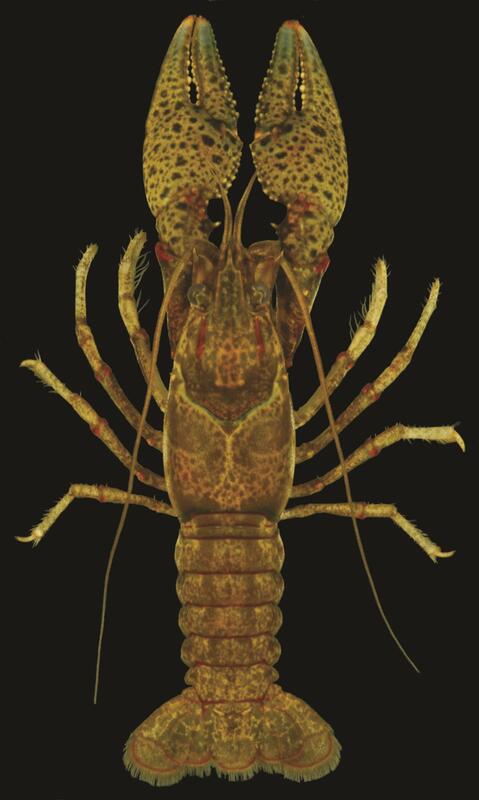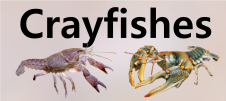







Loading profile. Please wait . . .
Faxonius palmeri (Faxon, 1884)
Gray-speckled Crayfish




Federal Protection: No US federal protection
State Protection: No Georgia state protection
Global Rank: G5
State Rank: SNA
Element Locations Tracked in Biotics: No
SWAP 2015 Species of Greatest Conservation Need (SGCN): No
SWAP 2025 Species of Greatest Conservation Need (SGCN): No
2025 SGCN Priority Tier: None
Element Occurrences (EOs) in Georgia: 0
Habitat Summary for element in Georgia: Associated with rocks or woody debris in flowing and quiet areas of small streams to medium-sized rivers and reservoirs
The overall color of the Gray-speckled Crayfish is brown or light brown with abundant darker mottling. The claws are lighter than the body and are covered with dark speckling and larger splotches giving them a spotted appearance. The fingers of the claws are bluish-greenish and tipped in orange. There are red markings on the head region, at the joints of the legs, and along the rear margins of the abdominal segments. The areola is obliterated and there are two rows of tubercles along the mesial margin of the palm. The rostrum is parallel-side and has marginal spines or tubercles, and there is a single cervical spine or tubercle present. This species reaches a maximum total body length of about 85 mm (3.3 in). Note: Based on data presented by Crandall and De Grave (2017), this species was removed from the genus Orconectes and placed in Faxonius.
No other species that occurs with the Gray-speckled Crayfish has an obliterated areola and claws that are light with dark spots.
The Gray-speckled Crayfish is a stream dweller and is usually found beneath rocks or woody debris. It can be found in slow or fast moving water.
Crayfishes are considered opportunistic omnivores and likely feed on live and decaying vegetation, aquatic insect larvae, small fishes, and dead animal matter.
Stream dwelling crayfishes typically hide during the day and come out at night to feed. Reproduction usually occurs during the spring and fall, but males in reproductive condition may be found at any time during the year. When female crayfish are ready to lay eggs, they usually find a secure hiding place and hence are rarely encountered. When the eggs are released, the female attaches them to her swimmerets and is said to be “in berry.” Upon hatching, the juvenile crayfish are attached to the mother by a thread. After the juveniles molt for the second time, they are free of the mother, but stay close and will hold on to her for some time. Eventually they move off on their own. Crayfishes molt 6 or 7 times during their first year of life and most are probably able to reproduce by the end of that year. They molt once or twice a year for the remainder of their lives and live about 3 years. A detailed life history study of Orconectes palmeri palmeri was conducted by Payne and Price (1983) on a population monitored in western Tennessee. They found males in reproductive condition from October through March. Females with eggs were found from February through April.
Flipping larger rocks in just about any habitat in a stream should turn up this species. The animal can be pinned by hand or gently driven into a dipnet. Dipnetting through leaf packs, using a backpack electroshocker, or setting baited minnow traps overnight could yield specimens as well.
Faxonius palmeri is comprised of three subspecies which occur in the middle southern states of Oklahoma, Kansas, Texas, Missouri, Louisiana, Tennessee and Mississippi. In Georgia is has become established in the Flint and Chattahoochee river systems. It is most commonly found in the Flint River proper between Lake Blackshear and Lake Seminole but is found in several Flint River tributaries as well as sites above Lake Blackshear dam.
Since this species is not native to Georgia, no threats are recognized.
This species is not native to Georgia and should be considered invasive.
This species is introduced in the Flint River system and appears to be displacing the native White Tubercled Crayfish, Procambarus spiculifer (Sargent et al. 2011). Orconectes palmeri is most common in the mainstem Flint but is now showing up in Flint tributary streams and the Chattahoochee River system. Of great concern is the threat to the Muckalee Crayfish, P. gibbus, which is found only in tributaries to the Flint (primarily Muckalee Creek). The Gray-speckled Crayfish has now been collected in the lower end of Muckalee Creek, and if it is able to colonize that system, the persistence of the Muckalee Crayfish is in doubt. Under no circumstances should crayfishes be moved from one waterbody to another. If using crayfish for bait, only use them in the stream in which they were captured. Ideally, any specimens of this species encountered should be collected and humanely euthanized by freezing.
Crandall, K.A., and S. De Grave. 2017. An updated classification of the freshwater crayfishes (Decapoda: Astacidea) of the world, with a complete species list. Journal of Crustacean Biology 2017:1-39.
Hobbs, H.H., Jr. 1981. The crayfishes of Georgia. Smithsonian Contributions to Zoology 318:1–549.
Payne, J.F., and J.O. Price. 1983. Studies on the life history and ecology of Orconectes palmeri palmeri (Faxon). Pp 183–191, In Freshwater Crayfish V, C.R. Goldman, ed. AVI
Sargent, L.W., S.W. Golladay, A.P. Covich, and S.P. Opsahl. 2011. Physicochemical habitat association of a native and a non-native crayfish in the lower Flint river, Georgia: implications for invasion success. Biological Invasions 13:499–511.
Taylor, C.A., G.A. Schuster, J.E. Cooper, R.J. DiStefano, A.G. Eversole, P. Hamr, H.H. Hobbs III, H.W. Robison, C.E. Skelton, and R.F. Thoma. 2007. A reassessment of the conservation status of crayfishes of the United States and Canada after 10+ years of increased awareness. Fisheries 32:372–389.
Christopher E. Skelton
C. Skelton, 2012: original account
C. Skelton, March 2019: general update of account.
D.Weiler, September 2019: photo added